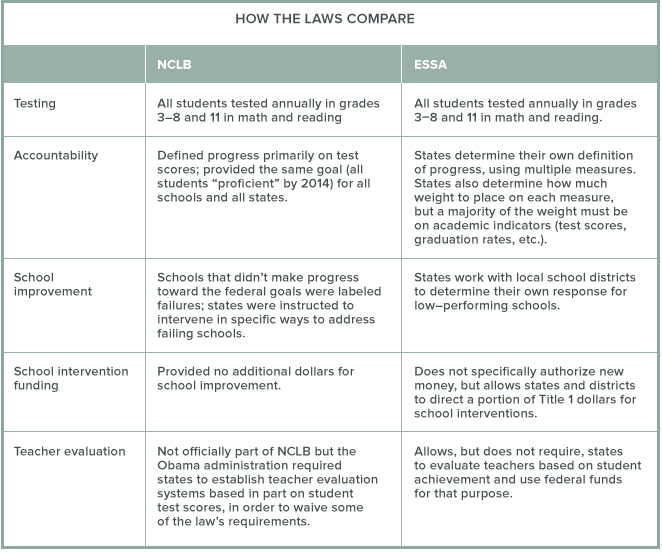Since it passed in 2001, many states—including California—have chafed under the requirements that No Child Left Behind (NCLB) attached to billions of dollars in federal K–12 education aid. Congress voted to replace the law this week, reauthorizing those aid programs and loosening those strings—a lot. The president signed the bill yesterday.
This new flexibility comes at a good time for California. The state is in the middle of implementing a new K–12 accountability system and the new federal law, the Every Student Succeeds Act, or ESSA, gives California a chance to prove that its approach to improving schools can work—without running the risk of losing federal money.
NCLB and subsequent Obama administration programs dramatically increased the federal role in K–12 education, particularly when it came to accountability. NCLB required most students to take tests in math and reading every year. The results of those tests were used to determine whether or not a school was successful. Failing schools were required to take certain actions. If a state didn’t follow the rules or couldn’t make progress in improving its failing schools, it risked losing federal funding.
While NCLB provided a one-size-fits-all approach to accountability, the new law lets each state devise its own system, as long as it meets some core criteria:

It took eight years of legislative wrangling to produce ESSA. During that time, the message from state education chiefs was consistent: We believe in accountability, but give us the flexibility to do it our own way. They now have that flexibility, and with it, the responsibility to demonstrate they can hold schools accountable.
Luckily, the new federal law appears to mesh well with California’s plans for its accountability program. The State Board of Education is currently working to align its program with the eight state priorities defined in the Local Control Funding Formula (LCFF), which determines how state money is allocated to schools. The board has suggested that it will discontinue the Academic Performance Index—which ranked schools on a scale from 200 to 1,000, based on student scores on state proficiency tests—and replace it with a “dashboard” of indicators that will provide information on the LCFF priorities.
It would be a welcome development if California could merge its state and federal accountability programs. In our 2014 report, Designing California’s Next School Accountability Program, we found that separate state and federal measures were confusing and sent mixed messages to educators and the public. An approach to accountability that uses multiple measures and incorporates LCFF performance data could fix that problem and generate more accurate and useful accountability information. But there are critical steps for the state to take, including:
- Ensuring data are accurate. The law calls for valid and reliable indicators of student or school performance, so that data can be compared across schools and districts. Currently, we do not have definitions of several of the LCFF indicators, including student suspension and graduation rates, that allow good comparisons.
- Focusing on what’s most important. There are twenty-two performance measures across the eight state priorities in the LCFF. The state can help schools by including only the most important goals and measures in its new accountability program.
- Supporting the local improvement process. More resources and attention should be given to developing a robust program of technical assistance for schools and districts. The state needs to recognize that local educators do not always know how to accomplish state goals. In fact, our report on LCFF implementation finds that the problem of technical know-how includes activities such as planning and budgeting to support school improvement.
While the fit between the new federal law and the Local Control Accountability Plan approach is promising, the new ESSA also raises questions about using a dashboard of indicators to assess school performance. The ESSA requires states to intervene in the lowest performing 5 percent of schools. State board members have been quoted as saying that the new system will not reduce school performance to one number—as the API did. It will be interesting to see how the state identifies schools that need improvement, since a dashboard approach implies using multiple measures of performance.
The passage of ESSA recognizes that using the states as laboratories of democracy is a robust approach to school accountability. California, with LCFF, has already started its experiment. The new federal law requires state accountability plans to be ready by school year 2017–18. The state board will be spending a lot of time in the lab until then.



